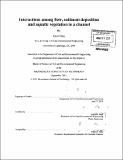| dc.contributor.advisor | Heidi M. Nepf. | en_US |
| dc.contributor.author | Zong, Lijun | en_US |
| dc.contributor.other | Massachusetts Institute of Technology. Dept. of Civil and Environmental Engineering. | en_US |
| dc.date.accessioned | 2012-05-15T21:11:02Z | |
| dc.date.available | 2012-05-15T21:11:02Z | |
| dc.date.copyright | 2011 | en_US |
| dc.date.issued | 2011 | en_US |
| dc.identifier.uri | http://hdl.handle.net/1721.1/70770 | |
| dc.description | Thesis (S.M.)--Massachusetts Institute of Technology, Dept. of Civil and Environmental Engineering, 2011. | en_US |
| dc.description | Cataloged from PDF version of thesis. | en_US |
| dc.description | Includes bibliographical references (p. 69-72). | en_US |
| dc.description.abstract | Aquatic vegetation is commonly present in rivers in many forms. This thesis consists of two studies, which examine the flow structure around a patch of emergent, rigid vegetation in a laboratory channel. The vegetation patch is represented by an array of circular cylinders in a staggered arrangement. The first study investigates flow structure and deposition pattern associated with a long patch of vegetation located at the sidewall of a channel (i.e. a partially vegetated channel). Along the flow-parallel edge of the patch, a shear layer is formed due to the velocity difference between the open region and the vegetated region. Coherent vortices are formed via Kelvin-Helmholtz stability in the shear layer, which also induces an edge wave. Both the energetic vortices and the edge wave enhance the lateral mass transport. Particles were introduced to the flow in order to observe the patterns of net deposition within and around the patch. There are two sources of particle flux to the patch: the advection of particles across the upstream leading edge and the lateral dispersion of particles from the adjacent open channel. The relative contribution of these two supplies determines the spatial pattern of net deposition in the patch. A simple model was developed to find the empirical value of the lateral dispersion coefficient. Longitudinal and lateral length scales were found to determine the region where particles cannot be delivered and the net deposition is limited by particle-supply. In the second study, a circular patch of emergent model vegetation located in the middle of the channel was examined. Its diameter was smaller than the channel width. Velocity measurements and flow visualization were conducted to study the turbulent wake behind the patch. Compared to the wake behind a solid obstruction, the wake behind a patch of vegetation (i.e. a porous obstruction) is different. Because of its porosity, some of the flow can pass through the patch, so that directly downstream of the patch there is a region of steady stream-wise velocity with no transverse velocity. This region is called the steady wake and it is also observed from the flow visualization. Unlike the wake behind a solid obstruction, the formation of a von-Karman vortex street behind a porous obstruction is delayed until the end of the steady wake region. As the stem density decreases (i.e. the patch becomes sparser), the velocity deficit in the steady wake region decreases and the length of the steady wake increase. | en_US |
| dc.description.statementofresponsibility | by Lijun Zong. | en_US |
| dc.format.extent | 72 p. | en_US |
| dc.language.iso | eng | en_US |
| dc.publisher | Massachusetts Institute of Technology | en_US |
| dc.rights | M.I.T. theses are protected by
copyright. They may be viewed from this source for any purpose, but
reproduction or distribution in any format is prohibited without written
permission. See provided URL for inquiries about permission. | en_US |
| dc.rights.uri | http://dspace.mit.edu/handle/1721.1/7582 | en_US |
| dc.subject | Civil and Environmental Engineering. | en_US |
| dc.title | Interactions among flow, sediment deposition and aquatic vegetation in a channel | en_US |
| dc.type | Thesis | en_US |
| dc.description.degree | S.M. | en_US |
| dc.contributor.department | Massachusetts Institute of Technology. Department of Civil and Environmental Engineering | |
| dc.identifier.oclc | 790491333 | en_US |
